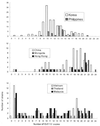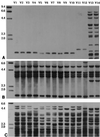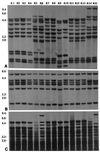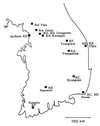Restriction fragment length polymorphism analysis of Mycobacterium tuberculosis isolated from countries in the western pacific region
- PMID: 10618086
- PMCID: PMC88694
- DOI: 10.1128/JCM.38.1.191-197.2000
Restriction fragment length polymorphism analysis of Mycobacterium tuberculosis isolated from countries in the western pacific region
Abstract
A total of 422 Mycobacterium tuberculosis isolates from eight countries were subjected to IS6110 and IS1081 DNA fingerprinting by means of restriction fragment analysis to characterize M. tuberculosis strains from each country. Chinese, Mongolian, Hong Kong, Filipino, and Korean isolates had comparatively more copies of IS6110 (proportion with eight or more copies; 95% +/- 5%), while Thai, Malaysian, and Vietnamese isolates had fewer copies (proportion with eight or more copies, 60% +/- 4%). We found a number of novel IS1081 types in this study. One IS1081 type was present in 56% of Filipino isolates, had a specific 6.6-kb PvuII fragment in its IS6110 DNA fingerprint, and was termed the "Filipino family." The IS1081 types of Thai isolates had interposing characteristics between the characteristics of northeastern Asian and southeastern Asian IS1081 types. A 1.3-kb single-copy IS6110 fragment was found only in Vietnamese M. tuberculosis isolates. Although M. tuberculosis isolates from each country had comparatively similar characteristics depending on the classification factor, each country's isolates showed characteristic DNA fingerprints and differed slightly from the isolates from the other countries in either the mode number of IS6110 copies or the distribution of IS1081 types.
Figures






Similar articles
-
Limited variation of DNA fingerprints (IS6110 and IS1081) in Korean strains of Mycobacterium tuberculosis.Tuber Lung Dis. 1995 Aug;76(4):324-9. doi: 10.1016/s0962-8479(05)80031-0. Tuber Lung Dis. 1995. PMID: 7579314
-
Molecular fingerprinting of clinical isolates of Mycobacterium bovis and Mycobacterium tuberculosis from India by restriction fragment length polymorphism (RFLP).J Vet Sci. 2004 Dec;5(4):331-5. J Vet Sci. 2004. PMID: 15613817
-
Insertion element IS1081-associated restriction fragment length polymorphisms in Mycobacterium tuberculosis complex species: a reliable tool for recognizing Mycobacterium bovis BCG.J Clin Microbiol. 1992 Jul;30(7):1772-7. doi: 10.1128/jcm.30.7.1772-1777.1992. J Clin Microbiol. 1992. PMID: 1352785 Free PMC article.
-
Combined use of Amplified Fragment Length Polymorphism and IS6110-RFLP in fingerprinting clinical isolates of Mycobacterium tuberculosis from Kerala, South India.BMC Infect Dis. 2007 Jul 28;7:86. doi: 10.1186/1471-2334-7-86. BMC Infect Dis. 2007. PMID: 17662148 Free PMC article.
-
Usefulness of IS6110-restriction fragment length polymorphism typing of Brazilian strains of Mycobacterium tuberculosis and comparison with an international fingerprint database.Res Microbiol. 2000 Jun;151(5):343-51. doi: 10.1016/s0923-2508(00)00157-1. Res Microbiol. 2000. PMID: 10919514
Cited by
-
Molecular Strain Typing of Mycobacterium tuberculosis: a Review of Frequently Used Methods.J Korean Med Sci. 2016 Nov;31(11):1673-1683. doi: 10.3346/jkms.2016.31.11.1673. J Korean Med Sci. 2016. PMID: 27709842 Free PMC article. Review.
-
First insights into the genetic diversity of Mycobacterium tuberculosis isolates from HIV-infected Mexican patients and mutations causing multidrug resistance.BMC Microbiol. 2010 Mar 17;10:82. doi: 10.1186/1471-2180-10-82. BMC Microbiol. 2010. PMID: 20236539 Free PMC article.
-
Molecular epidemiology of tuberculosis in a sentinel surveillance population.Emerg Infect Dis. 2002 Nov;8(11):1197-209. doi: 10.3201/eid0811.020403. Emerg Infect Dis. 2002. PMID: 12453343 Free PMC article.
-
Genotypic characteristics of Mycobacterium tuberculosis isolated from household contacts of tuberculosis patients in the Philippines.BMC Infect Dis. 2013 Dec 5;13:571. doi: 10.1186/1471-2334-13-571. BMC Infect Dis. 2013. PMID: 24308751 Free PMC article.
-
Mycobacterium tuberculosis Beijing genotype strains associated with febrile response to treatment.Emerg Infect Dis. 2001 Sep-Oct;7(5):880-3. doi: 10.3201/eid0705.017518. Emerg Infect Dis. 2001. PMID: 11747703 Free PMC article.
References
-
- Bhattacharya M, Dietrich S, Mosher L, Siddiqui F, Reisberg B E, Paul W S, Warren J R. Cross-contamination of specimens with Mycobacterium tuberculosis, clinical significance, causes, and prevention. Microbiol Infect Dis. 1997;109:324–330. - PubMed
-
- Braden C R, Temleton G L, Cave M D, Valway S, Onorato I M, Castro K G, Moers D, Yang Z, Stead W W, Bates J H. Interpretation of restriction fragment length polymorphism analysis of Mycobacterium tuberculosis isolates from a state with a large rural population. J Infect Dis. 1997;175:1446–1452. - PubMed
-
- Cave M D, Eisenach K D, McDermott P F, Bates J H, Crawford J T. IS6110: conservation of sequence in the Mycobacterium tuberculosis complex and its utilization in DNA fingerprinting. Mol Cell Probes. 1991;5:73–80. - PubMed
MeSH terms
Substances
LinkOut - more resources
Full Text Sources

